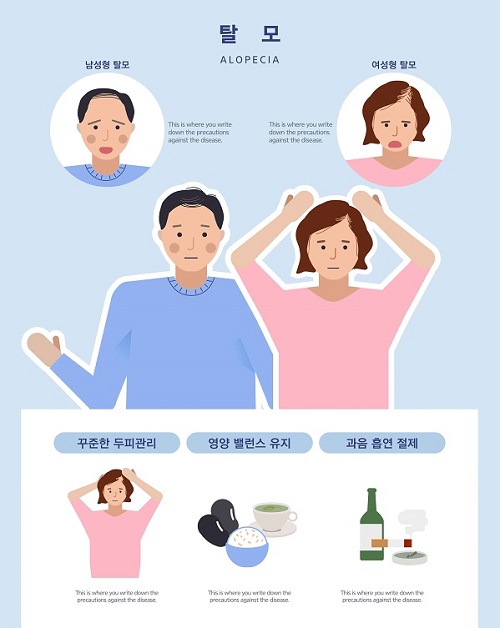Men should look out for "M" shape hairline, and women for hair loss at the crown.
Consistently taking oral remedies brings improvements.
The number of patients with hair loss is increasing in Korea. According to Health Insurance Review & Assessment Service, the number of patients with alopecia consistently increased for the last five years, and female patients also recorded a steady increase.
There are various types of alopecia depending on the causes. Among these, androgenic alopecia is most common. It can be classified into male and female pattern alopecia, but knowing the characteristics of each is necessary as there are differences.

■Androgenic Alopecia, the cause is…
Androgenic alopecia occurs as a result of genetic predisposition and androgen (male hormone). Androgens affect the growth of hairs and are of different types in our bodies. Among them, testosterones turn to dihydrotestosterones (DHT) due to 5α-reductase once they reach the follicles.
DHT has the characteristics of constricting the follicles and gradually thinning out the hairs—which cause hair loss in men with the genetic predisposition. Besides, 81.5% of the patients with male pattern baldness have fathers who have moderate to severe alopecia symptoms.
For women, estrogens can restrain androgens, but hormone imbalance or decrease of estrogen after middle age occurs, androgens excessively secret and cause alopecia.
■Progressing aspect of alopecia in men and women
Androgenic alopecia is a progressive disease that missing the treatment period is fatal. Dr. Huh Chang-hun at the Department of Dermatology, Seoul National University Bundang Hospital, said, “There are two types of alopecia forms: hair falling out and thinning out. For hair falling out—like anagen and telogen effluvium, alopecia areata, etc.— the average number of hairs that used to fall around 100 a day increases to hundreds or intensively falls from only one spot. On the other hand, androgenic alopecia, which most commonly occurs, does not is about losing hair, but makes it look like thin-haired as hairs thin out more than that of other areas."
Male pattern baldness progresses as hair thins at the forehead and the crown in an “M” shape. As the result, the forehead hairline recedes, and the scalp is clearly exposed, but the back hair is relatively maintained. If you look in the mirror and find your hairline is receded backward compared to the past, then suspect hair loss and go see a doctor as soon as possible.
For female pattern alopecia, the hairline is relatively preserved, while the hair at the crown slowly thins and progresses into tree-shaped alopecia. Their hair loss is less severe than that of males, and that complete baldness or forehead hair loss is hard to find.
In the early stage of female pattern baldness, it begins at the crown where it is hard to observe. But if you notice hair growing thinner or empty spots at the crown, you should suspect hair loss.

■Treatments for Male/Female
The basic treatment for androgenic alopecia is drug therapy. Depending on the condition, topical application or oral drug is considered.
The most typical topical treatment is minoxidil that stimulates the anagen phase and suppresses the telogen phase. Males apply 5% of the solution and females use 3%. Oral drugs that are most used are finasteride and dutasteride. These drugs are widely known to restrain testosterones from turning into dihydrotestosterones.
Dr. Lee Un-ha at the department of dermatology, Inje University Sanggye Paik Hospital, said, “Oral remedy for hair loss begins to show effects after six months of taking it and reach its peak after 12 months. Hence, consistently taking the medicine is more important than anything else.”
Female pattern baldness is harder to treat than male pattern baldness. Women in their childbearing age should pay particular attention when taking oral medicines.
Dr. Lee said oral drugs for male pattern alopecia may cause deformity of male fetuses, and that in general, women after menopause can take the remedy. The most common topical treatment for female pattern alopecia is minoxidil, and applying it twice a day for more than six months shows the efficacy of more than 30%.
If the oral drugs do not work or hair loss has already progressed too far, a hair transplant can be an option. Hair transplant surgery is implanting hair taken from the back or the sides to bald spots, and the hair stays as it is forever. However, other areas continue to lose hair, requiring oral therapy after the surgery.
TIP. How to Prevent and Manage Hair Loss
1. Keep your scalp clean : body wastes, dandruff, etc., piled up on the scalp are risk factors of hair loss
2. Reduce scalp irritation like perming and dyeing and wash it clean after using hair styling products.
3. Have a nutritionally balanced diet : protein, calcium, vitamin D, minerals, etc., are nutrients necessary for hair growth
4. Protect your scalp from the UV lights : remember to wear a hat or carry a parasol on days of strong sunlight
5. Relieve stress : too much stress hampers the hair growth
6. Quit smoking : nicotine in cigarettes contracts blood vessels, promoting hair loss
7. Be patient : hair loss is not a disease that can be cured within a short period of time. Consistent treatment can bring efficacy.
8. Don’t have blind faith in shampoo, supplements, etc. : Products, not scientifically proven, can not only cause side effects but also economic & time losses. Hair loss should be managed with treatments best fit for the type after an accurate diagnosis is made.


